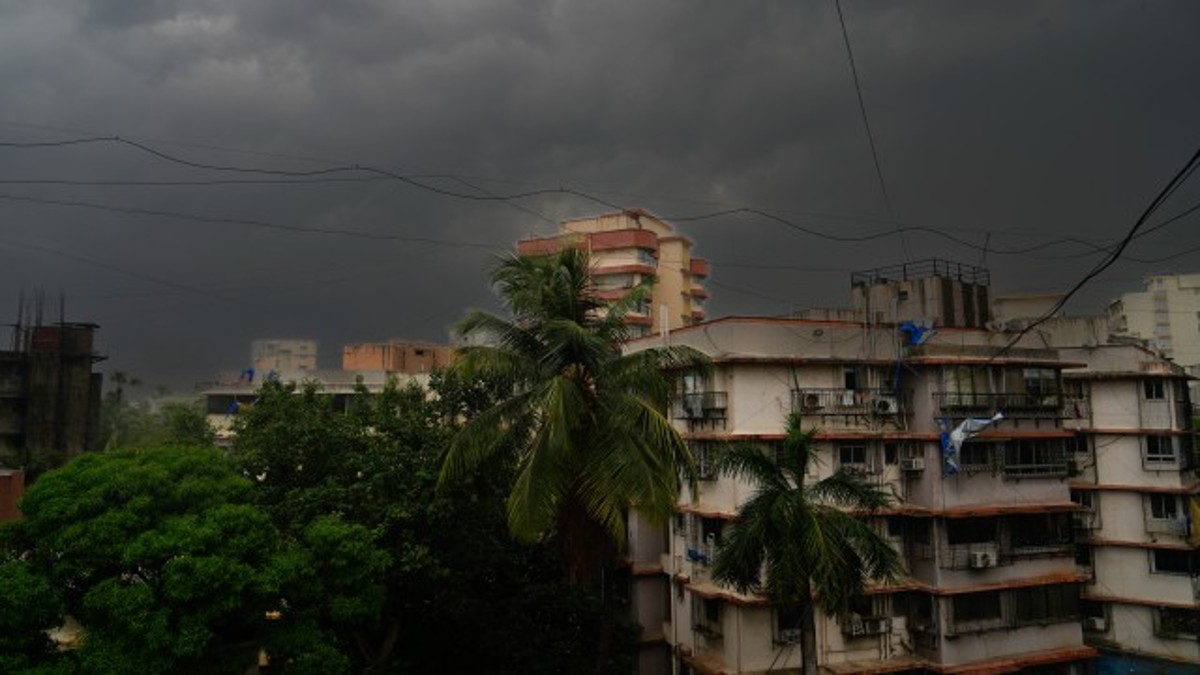Mumbai was caught off guard by strong winds, unseasonal rain, and a massive dust storm on Monday. However, besides the destruction, dust storms may also have negative effects on people’s health, triggering allergic reactions, breathing issues, cardiovascular complications, skin problems, and itchy and burning eyes read more
)
Dark clouds hang over during a pre-monsoon thunderstorm accompanied by strong winds and rain in Mumbai, India, Monday, 13 May 2024. AP
Mumbai was caught off guard by strong winds, unseasonal rain, and a massive dust storm on Monday.
An illegal billboard fell in Ghatkopar, killing more than a dozen and injuring several others.
Flight and train services were temporarily suspended, hundreds of trees were uprooted and heavy traffic was snarled due to accidents.
However, besides the destruction, there are also potential health impacts of dust storms on people.
Let’s take a look.
Dust storm wreaks havoc in Mumbai
At least 14 people were killed and 74 injured after a 100-foot tall illegal billboard fell at a petrol pump in Ghatkopar’s Cheddanagar Junction during dust storms and rains, as per civic officials.
Chief Minister Eknath Shinde visited the spot of the hoarding collapse incident in Ghatkopar late in the evening and ordered a structural audit of all hoardings in Mumbai city. He also announced five lakh compensation for the kin of the deceased, according to PTI.
This comes a few hours after the National Disaster Response Force (NDRF) reached the spot to rescue the people trapped under the rubble. BMC commissioner Bhushan Gagrani said that 20 to 30 are still trapped.
In Bandra, a branch of a tree fell on a shop, trapping two people. “Of them, a 38-year-old died while another person was seriously injured,” a civic official said.
A total of 187 incidents of tree or branch fall were reported in Mumbai and suburbs, the Brihanmumbai Municipal Corporation said. Of these, 16 incidents occurred in the island city, 104 in the eastern suburbs and 67 in the western suburbs.
In Wadala, an under-construction metal parking tower collapsed on a road amid gusty winds, injuring three people and damaging vehicles. Of the total injured persons, 56 were admitted to Rajawadi Hospital and others were admitted to three separate hospitals.
One person was injured when the iron gate of a housing society collapsed, while a person practising on a yacht in the sea sustained a minor injury due to gusty winds.
The unseasonal rain and dust storms led to the suspension of flight operations at Mumbai airport for an hour in the evening due to low visibility, services of local trains were delayed, and traffic snarls were seen in several areas.
As many as 15 flights were diverted to different airports and the runways operation resumed at 5.03 pm, the airport operator said.
Local train services on the Central Railway were suspended for more than two hours after the overhead equipment got damaged between two stations due to the storm and rains, inconveniencing passengers in the evening rush hour. Western Railway services were also delayed by at least 15–20 minutes.
Several parts of Mumbai witnessed heavy traffic snarls due to incidents of trees falling and rain. BEST buses were diverted at some locations due to rain and falling trees.
Also read: Chaos and destruction after dust storm hits Mumbai: How is it caused?
Health impacts
The health impacts of sand and dust storms can be serious.
Dust storms can lead to an allergic reaction in patients with asthma.
Of particular concern are PM10 particles.
“These are very very fine, very mobile when dry, and easy to inhale into the lungs. Here they can damage tissues – not least as PM10s are often comprised of small (sometimes microscopically sharp) particles of quartz,” The Telegraph quoted Prof Thomas.
According to Health Shots, exposure to particulate matter can also lead to cardiovascular complications, such as increased risk of heart disease, stroke, blood pressure, and other diseases.
Exposure to such harmful particles in the air can also lead to several skin problems.
Dr Bangia told Health Shots, “Dust particles and pollutants can strip the skin of its natural oils, which can make your skin feel dehydrated. Then there are cases of allergic reactions that happen because these dust particles cause irritation, allergies and various kinds of hives.”
Another consequence of getting exposed to dust particles is itching and burning eyes.
A study in the International Journal of Environmental Research and Public Health reported that continuous exposure to dust particles can lead to eye conditions as well.
Experts also found a link between meningitis outbreaks and these storms. The “African Meningitis Belt,” a region of sub-Saharan Africa, has the largest concentration of the illness, according to The Telegraph. Due to its high fatality rate, quick onset, and tendency to leave survivors brain-damaged or deaf, it is one of the most feared diseases in Africa.
According to one explanation, dusty environments harm the epithelial cells that line the throat and nose, making it possible for bacteria and other diseases to enter the circulation. This results in symptoms including photophobia, severe headaches, and vomiting by infecting and inflaming the membranes that surround the brain and spinal cord.
A worrying global trend
The skies turning an apocalyptic orange or dark might be a frequent sight in the coming years.
This is because sand and dust storms are reportedly becoming “increasingly frequent and severe” across large parts of the globe, according to the United Nations.
The United Nations Convention to Combat Desertification (UNCCD) said an estimated two billion tonnes of sand and dust enters the atmosphere every year, wreaking havoc across large parts of Asia and Africa and causing significant economic damage throughout the world.
Strong winds create storms as they sweep across dry regions without plant covers, picking up dust and carrying it to the low-level atmosphere. These gusty winds transport them for thousands of kilometres, crossing deserts, countries and even oceans, as per The Telegraph.
Ahmedabad witnessed a sudden change in weather on Monday evening, 13 May 2024, as strong winds and a duststorm accompanied by light rainfall in the evening reduced visibility in the city. Hoardings were damaged in Ahmedabad, and a mobile tower got uprooted in Gandhinagar, with no report of casualties.
A police post collapsed due to strong winds at Vadia in Banaskantha district. In its latest forecast, the IMD said light thunderstorms with lightning were likely at isolated places in Aravalli, Dahod, Mahisagar, Dangs, Valsad, Surendranagar, Rajkot, Ahmedabad, Anand, Bharuch and Surat in the next two days.
After days of severe heatwave, Delhi-NCR and parts of North India experienced high winds with dust and debris in the late hours on 10 May, creating an orange blanket. The gusty winds, according to The Quint, killed two and injured at least six people.
Similar scenes were witnessed in October last year, when the National Capital was covered with a blanket of orange dust, lowering the air quality and reducing the visibility to over 1,000 metres, as per the India Meteorological Department (IMD).
In Greece, millions of people deal with the fallout from one of the worst dust storms to hit in six years. The authorities have issued an advisory, especially asking those suffering from respiratory conditions to limit their time outside, The Telegraph reported.
Last year, in September, parts of the United Kingdom were engulfed with hazy skies and orange clouds of dust.
In 2022, Iraq was hit by 10 storms in just two months. The country recorded only a handful per year a decade ago, the report said.
The Great Plains in America had twice as many storm reports by 2020 as there had been in the past 20 years.
The same year, a storm known as Godzilla caused record-breaking “hazardous” levels in the Sahara.
What’s behind it
Scientists have highlighted agricultural practices, water use, soil management, deforestation, urbanisation, and climate change as possible contributors to the dust storms.
These kinds of activities contribute to the “desertification” phenomenon, which is the progressive conversion of productive land into an arid desert. Furthermore, more desert equals more storm fuel.
Recent studies by the UN estimate that human activity is responsible for at least 25 per cent of the world’s dust emissions.
Professor David Thomas, from the Oxford University Centre for the Environment, was quoted by The Telegraph, “Any human action on the margins of deserts… that reduces the size of water bodies or which removes natural vegetation, enhances the risk of dust storms if the underlying sediments and soils are fine enough to be picked up by the wind.”
He cites the depletion of the Iraqi marshes during the First Gulf War by Saddam Hussain and the drying out of the Aral Sea between Kazakhstan and Uzbekistan as examples of human-caused events that have produced artificial dust sources.
But most of them are also unrelated to humans.
“We must disaggregate what is natural, and what is potentially enhanced by human agency,” said Prof Thomas, while citing the Sahara as a “natural source of dust.” Dry lake beds, inherited from water climate conditions in the distant past, are all around the world sources of dust.
Action needed
To reduce the potential impacts of these storms, the UN urges high-risk countries to consider forecasting tools and early warning systems.
The global agency has recommended a practice of land restoration, which uses soil and water management techniques to increase vegetative cover,
Funding efforts to combat desertification and degradation was also a major challenge, Ibrahim Thiaw, UNCCD executive secretary, told Reuters, noting that just $15 billion was made available over 2016-2019 to tackle problems spanning 126 countries.
Notably, China is leading the way here with its ambitious tree-planting project.
As per The Telegraph, under the Green Great Wall initiative that began in 1978, more than 66 billion trees have been planted, with 100 billion planned by 2050.
The Xi Jinping-led country has also developed an AI tool, nicknamed Dust Watcher, to predict storms and save economies millions. The tool can predict the timing and severity of an incoming storm hourly and up to 12 hours in advance.
During a trial run last year, the tool made 13 per cent fewer errors than non-AI models, the report claimed.
With inputs from agencies
Vibhuti is on the Explainers team at Firstpost. She covers a wide range of topics including Indian political affairs, international relations, climate change, among others. She likes to split her free time between travelling, reading, and doing research. see more

 4 months ago
27
4 months ago
27


















)
)
)
)
)
)
)
 English (US) ·
English (US) ·